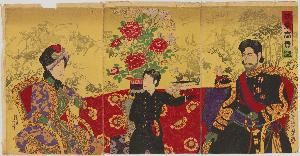Toyohara Chikanobu
Toyohara Chikanobu;Yoshu Chikanobu
Born: 1838
Death: 1912
Biography:
Toyohara Chikanobu, also known as Yoshu Chikanobu, was a Japanese painter and printmaker who lived from 1838 to 1912. He is best known for his depictions of historical events, landscapes, and portraits of famous figures in Japan's history. As a prolific woodblock artist, he played a significant role in the development of Japanese art during the Meiji epoch.
Early Life and Career
Toyohara Chikanobuwas born in 1838 in Japan. He began his career as an artist at a young age and quickly gained recognition for his skills in woodblock printing. His work often featured historical events, landscapes, and portraits of famous figures, which were highly regarded by the Japanese public.
Artistic Style and Contributions
Toyohara Chikanobu's artistic style was characterized by his use of vibrant colors and intricate details. He was known for his ability to capture the essence of traditional Japanese art while also incorporating modern techniques. His contributions to the development of Japanese art are still celebrated today, with many of his works on display at Wikioo.org.
- His paintings often featured historical events, which were highly regarded by the Japanese public.
- He was also known for his landscapes and portraits of famous figures.
- Toyohara Chikanobu's use of vibrant colors and intricate details was a key aspect of his artistic style.
Notable Works and Legacy
Some of Toyohara Chikanobu's most notable works include Cherry-Blossoms Bloom again (in front of) Kuruwa (House), which is a stunning example of Japanese art from the Meiji era. This woodblock print showcases the artist's ability to capture the essence of traditional Japanese art while also incorporating modern techniques. Kumoi-Zakura (Kumoi Cherry Trees) by Yoshida Hiroshi is another notable work that features a similar style. This painting is a great example of the shin-hanga style, which was a revival of traditional Japanese woodblock printing techniques. The painting Cherry-Blossoms Bloom again (in front of) Kuruwa (House) by Toyohara Chikanobu is a stunning example of Japanese art from the Meiji era. Created in 1888, this woodblock print showcases the artist's ability to capture the essence of traditional Japanese art while also incorporating modern techniques. In conclusion, Toyohara Chikanobu was a prolific woodblock artist who played a significant role in the development of Japanese art during the Meiji epoch. His contributions to the development of Japanese art are still celebrated today, with many of his works on display at Wikioo.org.














